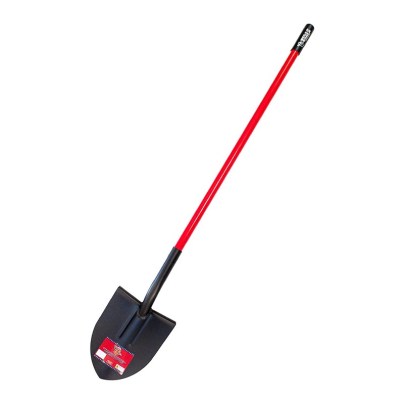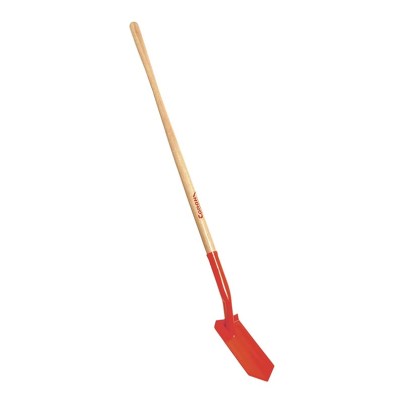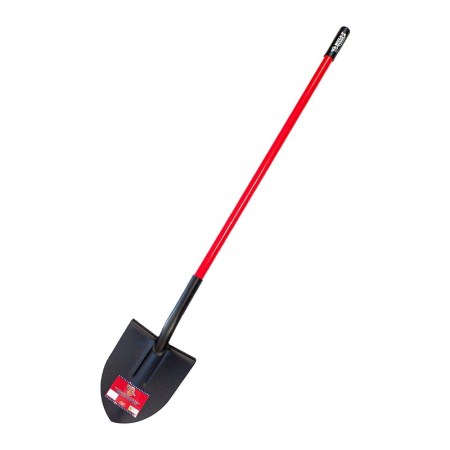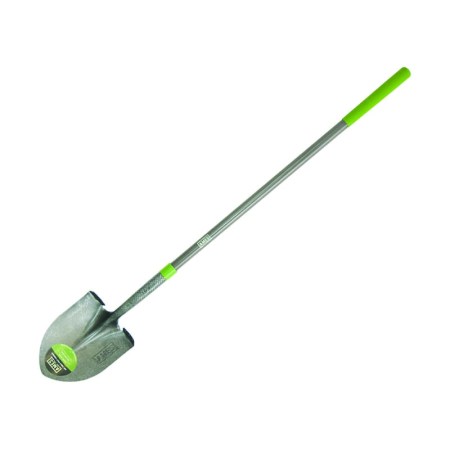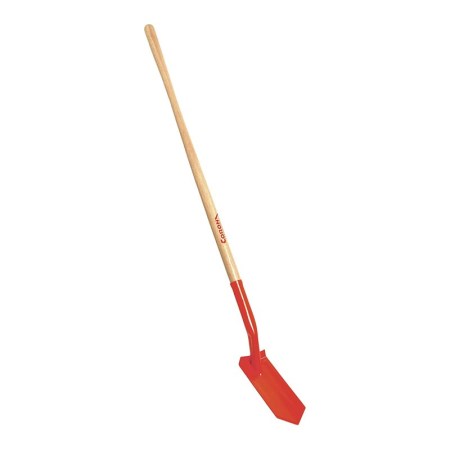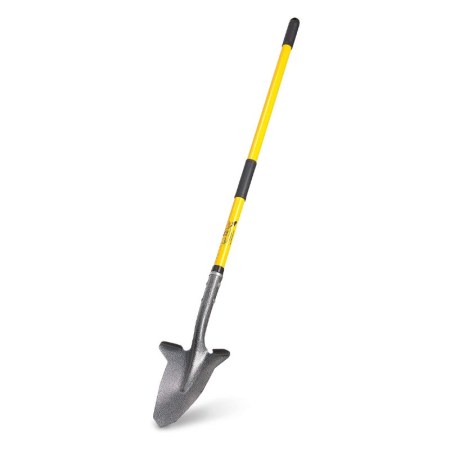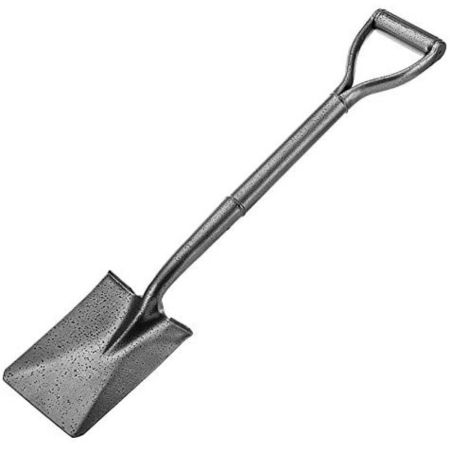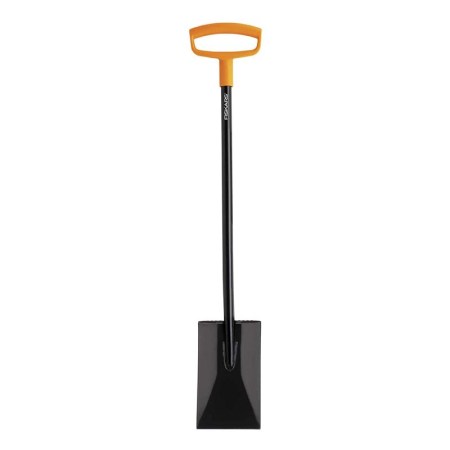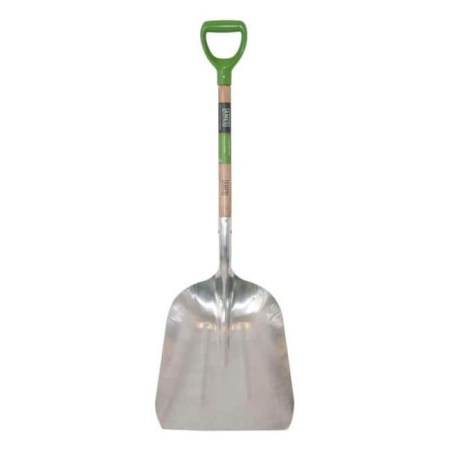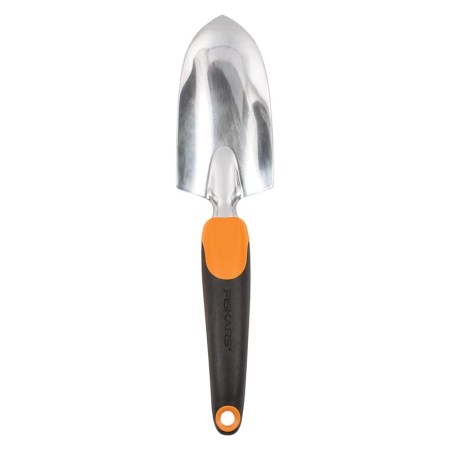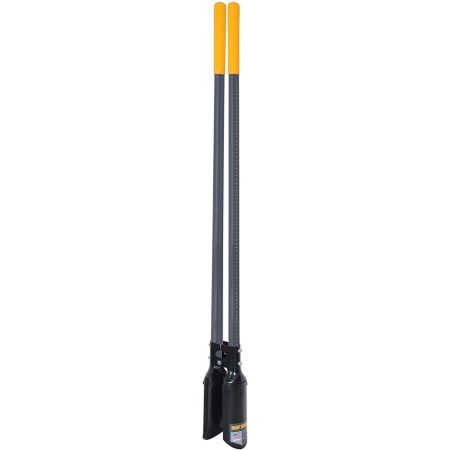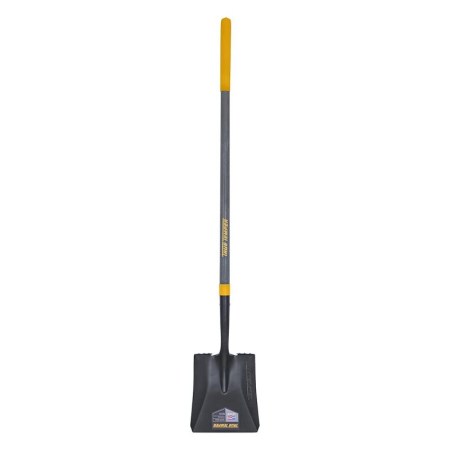We may earn revenue from the products available on this page and participate in affiliate programs. Learn More ›
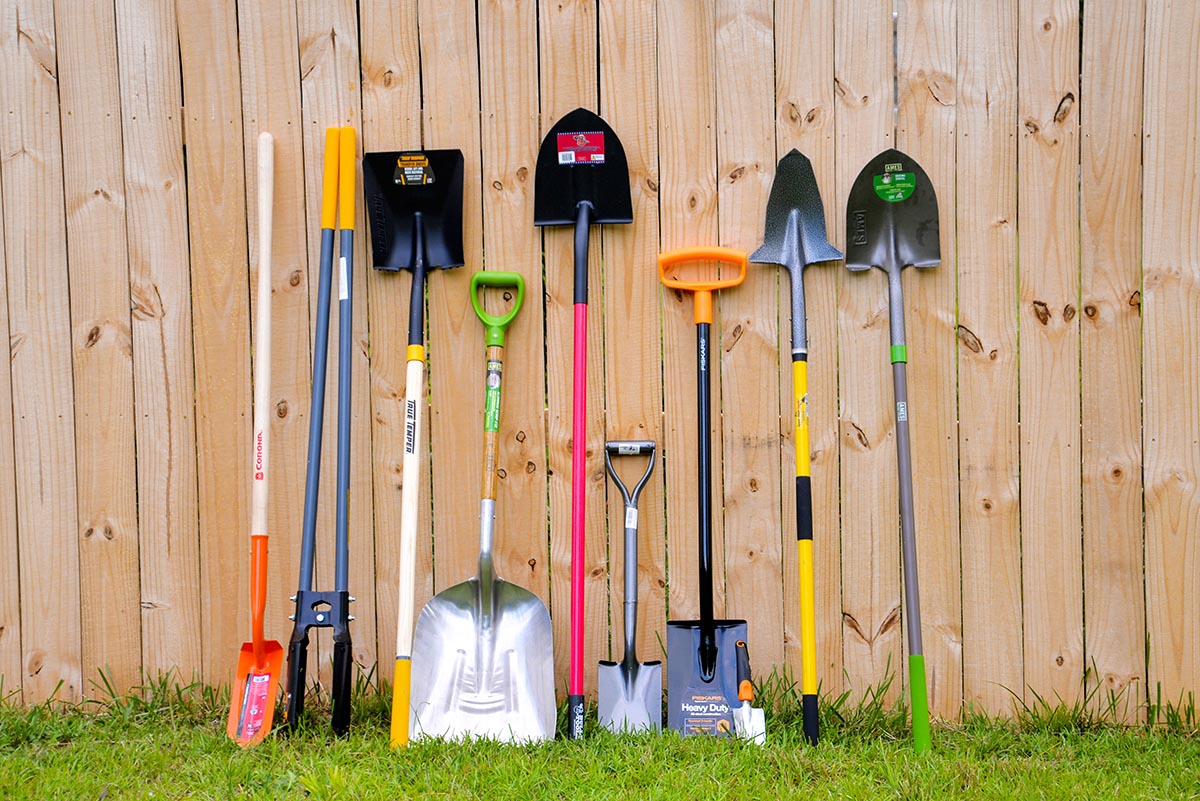
The smell of freshly turned earth, the weight of a sturdy shovel, and the view of healthy bedding plants just waiting to be placed tenderly into the ground can be a source of joy for many gardeners. Creating a garden you desire involves using the best gardening shovels to make yard and garden tasks easier on your body and your mood.
If you’re shopping for a new shovel, it can get confusing. Different models are specially designed for unique tasks, like digging holes for fencing, turning a garden bed, or trenching an irrigation system. To help narrow your search, we’ve rounded up, tested, and reviewed some really great shovels for the most common digging projects. Read on to learn how we chose these shovels and which might be the best shovel for your next project.
- BEST OVERALL: Bully Tools 12-Gauge Round Point Shovel
- BEST BANG FOR THE BUCK: Ames Long Fiberglass Handle Round Point Shovel
- BEST TRENCHING SHOVEL: Corona General Purpose Trench Shovel
- BEST TREE-PLANTING SHOVEL: Spear Head Spade Gardening Shovel
- BEST MINI SHOVEL: Z&G D-Handle Mini Spade Shovel
- BEST GARDEN SPADE: Fiskars Garden Spade Shovel
- BEST GARDEN SCOOP: Ames #12 Aluminum Scoop with D-Handle
- BEST GARDEN TROWEL: Fiskars Ergo Trowel
- BEST POSTHOLE DIGGER: True Temper Post Hole Digger with Fiberglass Handle
- BEST FLAT SHOVEL: True Temper Square Point Shovel
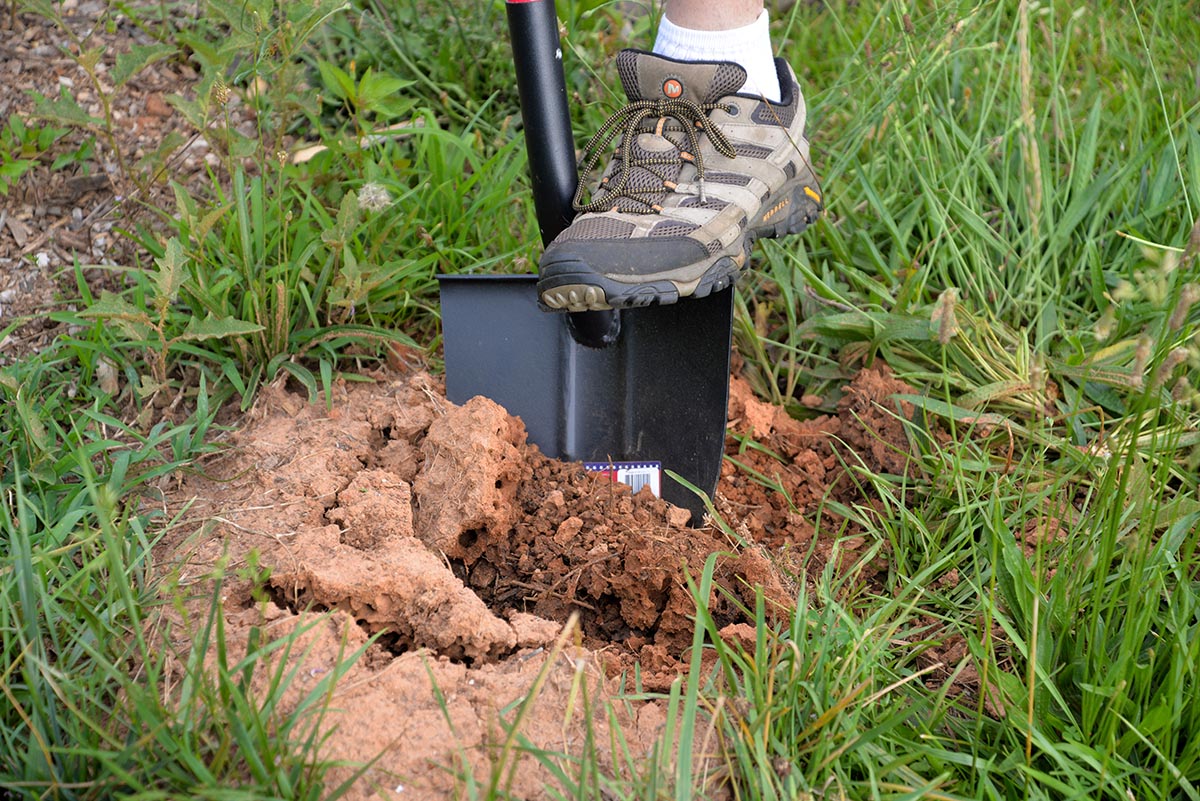
What to Consider When Choosing the Best Shovel
Before choosing one or more gardening shovels to help maintain the yard and garden, consider the following factors, including shovel type, material, construction, length, weight, and grip. With more information about these product factors, it’s much easier to determine the best shovels for planting gardens, trees, or shrubs.
Type
While most people have experience with a round-point or flat-head digging shovel, there are actually many more shovel types to consider. Based on blade shapes, handle design, and purpose, shovels can include digging shovels, trenching shovels, tree-planting shovels, edging shovels, mini shovels, trowels, spades, scoops, and posthole diggers.
- Digging shovels have a concave blade that typically includes a small flattened platform (collar), where the user can rest a foot for extra force when pushing the tool into the ground. Square digging shovels are useful for edging, transplanting shrubs and perennials, and trenching. Tools with a pointed tip are great for breaking up hard-packed soil, while round tips are ideal for softer soil and transplanting.
- Trenching shovels have long, narrow blades that come to a slight point. These handy tools are built for digging trenches to install or repair irrigation systems, or for digging drains.
- Tree planting shovels, as indicated by the name, are intended for quickly and effectively digging holes to plant trees. These shovels have a similar shape to trenching shovels, with narrow, curved blades and a pointed tip that penetrates through tough dirt to dig out circular holes for transplanting trees.
- Edging shovels aren’t made for digging. Instead, these shovels have broad semicircle blades and a straight footplate that you can step on to edge the lawn or garden. The blade cuts away the lawn or soil, creating a clean border that prevents grass from spreading to the garden or pathway and stops the spread of weeds from the garden into the lawn.
- Mini shovels are essentially similar to full-size shovels but with shorter shafts and slightly smaller blades that give the user better maneuverability in tight spaces. Some mini shovels also can fold in half, making them much easier to pack for a campsite.
- Trowels are a type of small, handheld garden shovel with a narrow rounded or pointed shovel blade. The shafts are only about 6 inches long, but the small size is ideal for digging up weeds in the garden without harming the surrounding plants. They are also useful for digging small holes for new plants.
- Spades have a flat-edge blade that’s perfect for cutting through roots or tough soil. Spades also are useful for moving small amounts of dirt, garden debris, or soil amendments because like with a shovel, the blade is normally somewhat concave. Spades often have a collar for adding extra foot power when needed.
- Scoops have large, flat blades with sidewalls to keep the contents in place. Garden scoops aren’t for digging, but they’re the tool of choice for moving large piles of dirt, soil amendments, leaves, and other debris, gravel, and mulch.
- Posthole diggers have a unique appearance that resembles two shovels connected at the shaft. The blades of the shovels are long and narrow, and they face each other, forming a scoop that can lift dirt straight up and out of a narrow hole.
Blade Material and Construction
Almost all digging shovels and garden spades have steel blades. Steel is heavier and more durable than aluminum. While aluminum is prone to denting and bending, it is less expensive and better at resisting rust. If you are considering a shovel with steel blades, look for models with a rust-resistant coating.
Low-end shovels generally have stamped steel blades, meaning the blade and attachment to the shaft was machine-stamped from a sheet of steel. High-quality shovels have forged blades, meaning the blade started as a single piece of heated steel that was then hammered into shape. Forged blade tools are more expensive, but they also last longer.
Also, take note of the socket where the handle is inserted into the blade, or head. Forged shovel heads have a solid socket with no seam, which makes for an extremely strong attachment. Stamped shovel heads have a narrow opening or seam at the back. If there is a seam, it may be reinforced either by welding or with a steel ring at the top called a collet. The seams on some shovels are not reinforced.
Shaft Length and Material
Garden shovels, spades, and scoops usually have a shaft between 44 and 48 inches long, which is a comfortable length for most people. There are also shorter shovels and spades, with shafts measuring between 18 and 24 inches in length. Longer shafts generally provide better leverage and are easier on the user’s back. When working in a confined area, a short shovel is usually the better choice.
The most common shaft materials for shovels are wood, fiberglass, and steel.
- Wood is usually the most affordable option, but these shovels may not stand up to tough jobs. Wood is prone to splintering and snapping from heavy use or age, plus wood is not as weatherproof as other materials.
- Steel is the heaviest type of shaft and is usually chosen for heavy-duty applications.
- Fiberglass is lighter than steel or wood, and it’s more flexible. It’s also durable and better at resisting rust and extreme temperatures.
Handle and Grip
Well-designed shovels have a handle and grip that provide good traction, protect against blisters, and limit hand fatigue. On longer tools, the grip is most often made of heavy plastic or rubber. Ergonomic tools have a textured grip, providing a more secure hold on the shovel.
Some shovels simply have a grip built into the shaft, others have a D-shaped or round handle, and a few have textured grips on both the shaft and the handle. D-shaped and round handles allow you to grasp the top of the shovel with one hand and the shaft with another for more leverage.
Weight
Most full-length garden shovels and spades weigh between 4 and 6 pounds, while some handheld tools weigh 2 pounds or less. Shovels containing fiberglass and aluminum fall on the lower end, while wood and steel shovels have more weight.
Consider a shovel’s weight carefully. A shovel may be heavier due to the materials that make it more durable in tough applications. While the extra weight might be worth it in some situations, a few extra pounds can make a noticeable difference after several hours of yard work. Ultimately, the ideal weight depends on the user’s own strength and endurance.
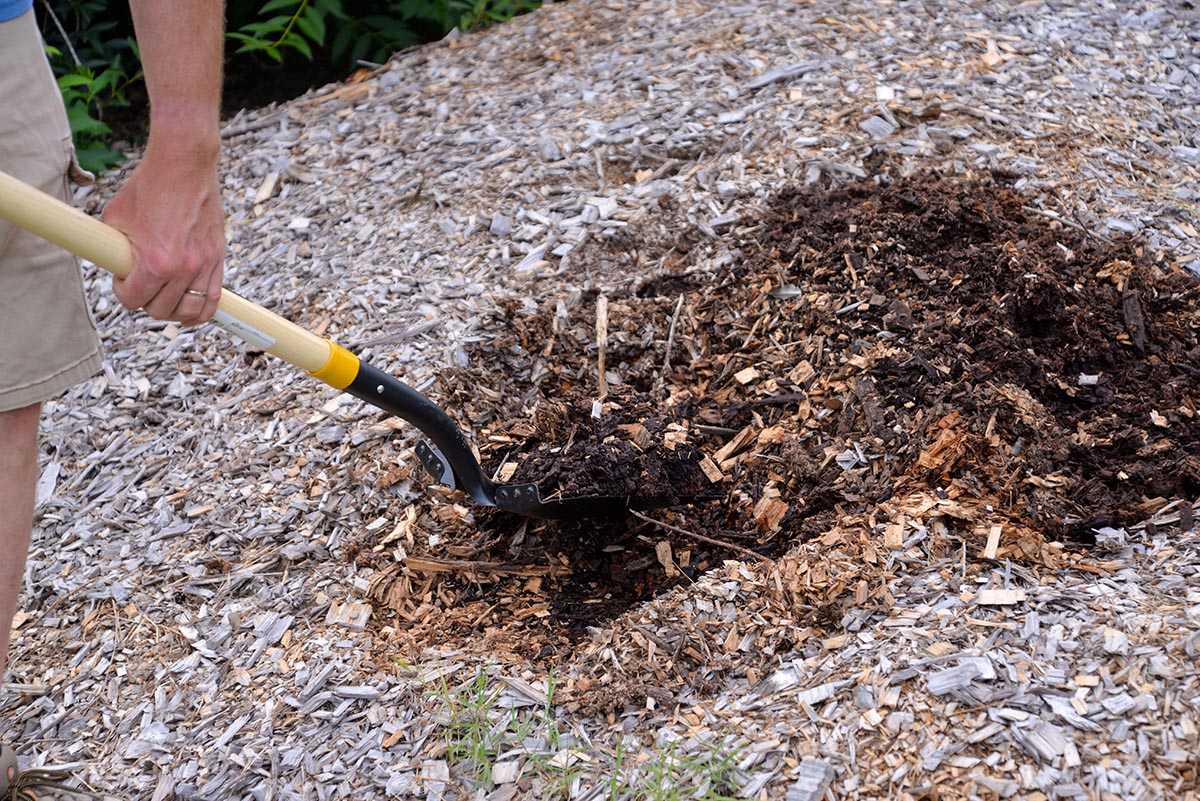
Our Top Picks
We selected these products based on the shopping criteria mentioned above and then tested them to find out how they would perform in average yard and garden projects. Check out our reviews to determine if one of these shovels is the right pick for your digging tasks when planting a garden or regularly caring for your landscape.
Best Overall
Bully Tools 12-Gauge Round Point Shovel
See ItThe most widely adopted shovel style for general-purpose digging is the long-handle round-point (LHRP) shovel. This model from Bully Tools features a stout 12-gauge head with a closed socket, a wide step, and welded reinforcements for added strength. The straight fiberglass handle includes a cushioned nonslip grip for added comfort and control.
The Bully Tools 12-gauge round-point shovel performed well throughout our tests. It powered through hard-packed clay soil and cut cleanly through sod and roots. The wide step area made it easy to use even while wearing soft-soled shoes instead of work boots. The handle offered just enough flexibility to absorb the shock of digging without bending under a load of soil.
One possible concern with this shovel is the welded area where the socket meets the blade—if you try too hard to pry out a rock or thick root (which you should not do), you could cause the metal surrounding the weld to break. Still, this is an excellent tool for all-purpose digging in the yard and garden.
Product Specs
- Type: Digging
- Handle: Fiberglass, straight
- Weight: 5.5 pounds
Pros
- Reinforced 12-gauge steel head
- Closed-back handle socket
- Strong fiberglass handle
- Slip-resistant cushioned grip
Cons
- Premium price
- Heavy welds around thinner metal might lead to cracking
Get the Bully Tools shovel on Amazon, The Home Depot, or Gemplers.
Best Bang for the Buck
Ames Long Fiberglass Handle Round Point Shovel
See ItThis long-handle round-point shovel from Ames punches above its weight. It features a durable steel-reinforced fiberglass handle with a padded nonslip grip for outstanding comfort and control. The steel blade features an oversize step area and an open socket that is reinforced with a steel collet. And it comes in at a value price.
Very little difference arose in testing between this Ames shovel and the Bully Tools model. The Ames shovel weighs just over a pound less, which makes it a better all-purpose choice for projects that don’t require heavy-duty reinforcements. The thinner steel used in the shovel head adds to its lightness but also allows it to flex slightly, so it is less aggressive in hard-packed clay soil and subject to more wear and tear in rocky ground. We like that this handle is reinforced with an inner layer of steel to help resist cracking at the stress points.
Product Specs
- Type: Digging
- Handle: Fiberglass, straight
- Weight: 4.31 pounds
Pros
- Tempered-steel head with wide step area for secure footing
- Steel-reinforced fiberglass handle
- Slip-resistant cushioned grip
- Lightweight but strong
Cons
- Open-back handle socket is possible failure point
- Thinner steel flexes in heavy-duty applications
Get the Ames round-point shovel at Hardware and Tools.
Best Trenching Shovel
Corona General Purpose Trench Shovel
See ItThere is no need to dig up more than necessary, especially when you’re installing hundreds of feet of pipe or cable. The unique shape of the Corona trench shovel makes it a great choice for digging narrow trenches or cleaning out a trench dug by a power trencher. The 12-gauge steel blade is 4 inches wide, so it removes less than half the width of a round-point digging shovel. The closed-handle socket features a high angle so it is easy to scoop out a flat trench bottom. The handle is made of lightweight hardwood for excellent strength and shock resistance.
The Corona trench shovel is purpose-built for making narrow trenches in any kind of soil. In our tests it dug easily into the heavy clay soil and worked smoothly around the rocks. The combination of lightweight handle and thick steel head made cleanout work efficient with easily guiding the head to the flat trench bottom. Unlike some “cleanout”-style trench shovels, this one does not have raised sides to hold in a large volume of loose material, but it digs a new trench in packed earth more efficiently than a cleanout shovel could. This is an essential tool for putting in irrigation and running power for landscape lighting, and it’s helpful for gardening tasks like digging out long planting furrows or paver borders.
Product Specs
- Type: Trenching
- Handle: Hardwood, straight
- Weight: 4.31 pounds
Pros
- Narrow head and deep handle angle for efficient trenching
- Rugged 12-gauge-steel head with closed-handle socket
- Impact-resistant hardwood handle
- Budget-friendly price
Cons
- Limited applications beyond trenching
Get the Corona shovel on Amazon.
Best Tree-Planting Shovel
Spear Head Spade Gardening Shovel
See ItWhether you are planting a new tree or transplanting a shrub to a different part of the yard, you’ll need a shovel that can contend with packed soil, random rocks, and tough roots. The Spear Head Spade gardening shovel is designed with those tough tasks in mind. The unique spearhead-shaped blade finds its way naturally to the path of least resistance. It is made of hardened manganese steel and features a wide step and sharp edge that slices cleanly through roots.
The open-back socket is reinforced with a steel collet and rubber gasket to boost strength and reduce shock. The straight fiberglass handle includes two padded nonslip grips for superior comfort and control with both hands.
We tested the Spear Head Spade model SHLF2 alongside our digging shovels and spades. It offered similar functionality to each type, with the loosening and scooping action of the digging shovels and the precision of the spades. It worked well in hard clay, and we even used it to transplant side shoots from a large oakleaf hydrangea. It cut easily through the thick main root coming off the parent plant and kept the root ball intact for easy removal to the new site. The compact, efficiently designed head and comfortable grips could make this a good choice for those with impaired strength and mobility, but the high price could be a barrier for some.
Product Specs
- Type: Tree planting
- Handle: Fiberglass, straight
- Weight: 4 pounds
Pros
- Unique head design for rocky, heavy, and hard-packed soils
- Manganese steel head cuts roots cleanly and stays sharp
- Comfortable padded grips
Cons
- Premium price
- Small surface area, works slowly
Get the Spear Head Spade shovel at Spear Head Spade Gardening Shovel.
Best Mini Shovel
Zu0026G D-Handle Mini Spade Shovel
See ItShort-handled shovels are useful when working in tight spots where wielding a longer shovel is impractical or impossible. With this mini shovel, gardeners can easily dig holes, move dirt, apply compost, or remove stubborn weeds with ease. The shovel has a strong metal shaft and a rust-resistant steel head.
This flat-head shovel is topped with a D-shaped nonslip grip to keep the user’s hands from cramping during work. A sharpened edge saves some effort when breaking up compacted soil. The mini shovel is a bit under 30 inches from top to bottom and weighs just under 2 pounds. When this little shovel arrived, we thought it was a toy. At 29 inches long, it is shorter than our tester’s shirt sleeves. When the blade is buried in the soil, the top of the handle is knee-high. But it is sturdily built and very lightweight.
The Z&G mini spade would make an outstanding first garden spade for a child. For most adults it is best suited for preparing soil in large containers or doing up-close work (on hands and knees) in raised beds. It is small and lightweight enough to use one-handed, larger than a trowel but smaller than a regular spade.
Product Specs
- Type: Spade
- Handle: Steel, D-handle
- Weight: 1.98 pounds
Pros
- Durable kid-size or on-knees garden spade
- Great for large container digging or cleaning ash from fireplaces
- Use with 1 or 2 hands
- All-steel construction
Cons
- Too small for most adults to comfortably use while standing
Get the Z&G shovel at Amazon.
Best Garden Spade
Fiskars Garden Spade Shovel
See ItWhether the goal is to slice through thick roots, neaten up the edges of the lawn, move a pile of compost or soil, or remove a section of lawn, the Fiskars garden spade is up to the task. With its steel shaft, this spade is extremely sturdy but weighs under 5 pounds.
A great feature is the extra-large D-shaped grip, which is big enough for both hands to grasp, providing extra control and strength while working. The comfortable, nonslip grip helps to drive the hardened-steel blade into compacted soil and clay without an issue. The flat-top blade is ideal for edging, trenching, and slicing through thick turf, making it a great choice for cutting and laying new sod.
We really liked the oversize D-handle, longer handle length, and well-designed reinforced blade on this Fiskars garden spade. The wide step and sharp blade made it easy to slice cleanly through dense sod without using excessive force, or to dig deep into heavy soil. The shaft is a bit longer than average, which is great for taller gardeners. The oversize D-grip and oval-profile handle made it comfortable and less fatiguing to control the blade angle while digging in or moving soil.
Since the rest of this shovel is steel, we would have preferred a built-in steel handle instead of the one made of polyresin with an attachment that can fail over time. Also, while the tool is welded, the metal around strong welds can break if stressed excessively. We would like to see stronger steel throughout the head instead of the added welds. Still, this would be an excellent long-lasting choice for moderate use.
Product Specs
- Type: Spade
- Handle: Steel, D-handle
- Weight: 4.81 pounds
Pros
- Durable construction
- Lightweight, medium-duty design
- Comfortable to work with
- Sharp edge for easier digging
Cons
- Poly handle is less durable than steel
- Thick welds could lead to breaks in tough conditions
Get the Fiskars spade shovel on Amazon or at The Home Depot.
Best Garden Scoop
Ames #12 Aluminum Scoop With D-Handle
See ItWhen users need to scoop and move fertilizer, mulch, soil amendments, lightweight gravel, or even a bit of snow, this Ames garden scoop is up for the challenge. The rustproof aluminum alloy blade curves up at the sides and back, so it can handle a large load without difficulty. The 26-inch hardwood shaft is topped with a soft, comfortable D-shaped grip that won’t slip when the user’s hands get sweaty. At less than 5 pounds, this lightweight tool is easy to use for longer periods of work in the garden or yard.
The Ames scoop shovel was, in a way, difficult for us to test. Unlike the other shovels in our lineup, it is not frequently used for working with soil. However, we found it useful for loading compost and mulch onto a wheelbarrow from a pile in the driveway. Like a giant transfer shovel, the oversized scoop head and flat edge worked extremely well moving the relatively lightweight particles piled on a hard, flat surface.
The lightweight scoop offered a generous payload capacity for quick transfer of large quantities. Farmers, homesteaders, and serious gardeners will appreciate this tool for working with soil amendments, fertilizers, and animal feed by the cubic yard.
Product Specs
- Type: Scoop
- Handle: Hardwood, D-handle
- Weight: 3.52 pounds
Pros
- Broad lightweight scoop blade
- Short handle and comfortable D-grip for excellent control
- Lightweight and easy to use
Cons
- Specialty shovel with limited application
Get the Ames D-handle shovel at The Home Depot or Acme Tools.
Best Garden Trowel
Fiskars Ergo Trowel
See ItThose who work in raised garden beds and containers or who plant lots of seedlings in their vegetable garden know the value of a good garden trowel. The Fiskars Ergo Trowel is a lightweight, inexpensive tool made of rust- and corrosion-resistant cast aluminum. The ergonomic cushioned hand grip has a textured nonslip coating for sure-handed gardening.
Although cast aluminum resists rust and corrosion really well, it is a brittle material that breaks easily. In our tests, which included planting 4-inch seedlings in average in-ground garden soil, this was not a problem. The Fiskars Ergo Trowel was lightweight, comfortable for users with vastly different hand sizes, and right-sized for planting small seedlings. We also used it to repot a few houseplants and to divide several clumps of oregano and thyme.
The edge was not really sharp enough to complete the herb divisions, but it worked the soil well and came in handy as a potting soil scoop. We did not attempt to pry up established perennials or to turn previously untilled soil, which probably would lead to damage. This is an excellent medium-duty trowel for working in established garden beds and potted plants.
Product Specs
- Type: Trowel
- Handle: Aluminum shaft with cushioned ergonomic handle
- Weight: 0.43 pound
Pros
- Lightweight and comfortable to use
- Rustproof
- Comfortable, slip-resistant grip
Cons
- Cast aluminum is not for levering rocks and roots
- Edge is marginally sharp
Get the Fiskars trowel shovel at Amazon, Target, or Blain’s Farm & Fleet.
Best Posthole Digger
True Temper Post Hole Digger With Fiberglass Handle
See ItPenetrate compacted soil and clay with the sharpened steel blades of this True Temper posthole digger, which precisely loosens and removes soil in preparation for fence posts, deck footers, and more. The durable steel blades are open when the handles are together and form a closed scoop when the handles are pulled apart to dig a perfectly round vertical post hole easily and without leaving loose dirt in the hole.
Despite the dual blades, this posthole digger weighs only about 9 pounds, thanks to the lightweight steel-reinforced fiberglass handles that measure 4 feet long. One handle has a built-in ruler to accurately measure the depth of the hole, and both handles are topped with high-visibility yellow cushion grips that aid the user by increasing control and comfort.
We tested this tool while installing a row of twenty 4×4 fence posts 30 inches deep. It was lightweight as advertised, weighing about 1 pound less than the wood-handled model we had used before testing. The fiberglass handles transmitted slightly more vibration and shock while breaking up soil but were more comfortable to grip. The pivot hinge worked smoothly.
The handles did not pinch the user’s hands like some of these tools are known to do. And it came at a competitive price, which is especially nice for a single-task tool that will spend lots of time in the shed after the project is finished.
Product Specs
- Type: Post-hole digger
- Handle: Fiberglass, straight
- Weight: 9.1 pounds
Pros
- Durable construction with steel-reinforced fiberglass handles
- Heavy enough to penetrate hardened clay soil, not too heavy
- Markings on the handle help gauge hole depth
- Comfortable grips
Cons
- Specialized tool with limited application
Get the True Temper post-hole shovel at Amazon, Acme Tools, or Hardware World.
Best Flat Shovel
True Temper Square Point Shovel
See ItThe best tool for moving piles of bulky material or cleaning up ice or mud from pavement is the flat shovel. We chose the True Temper square-point shovel because of its lighter weight and durability. The hardwood handle with nonslip cushioned grip saves weight and resists the shock and vibration that come with scraping up the last bits of soil or mulch off of pavement. The steel head features a wide step and open back and is secured to the handle with a steel ferrule.
In our tests the hardwood handle on the True Temper Square Point Shovel stood out in terms of general comfort. The hardwood is light and offers just the right amount of flex. The lightly textured surface is naturally easy to grip. With non-gloved hands the wood just feels better. The shovel worked well moving soil, mulch, and gravel from paved and unpaved surfaces alike.
True Temper also offers this shovel with a fiberglass handle or a shorter D-handle, which may be better for stabilizing heavier loads like gravel, but we liked this one very much as an all-purpose tool. A flat shovel is one of those tools that you may not realize you need until you have it. This is a good model to prove that point.
Product Specs
- Type: Transfer
- Handle: Hardwood, straight
- Weight: 4.75 pounds
Pros
- Durable materials
- Comfortable to work with
- Moves large quantities of material easily
- Cleans ice, soil, or mud from paved surfaces
Cons
- Open-back handle socket may loosen with heavy use
Get the True Temper square-point shovel on Amazon.
Our Verdict
For most garden and lawn-care projects, a long-handled round-point shovel is a necessity. In our opinion, it is best to start with the toughest one available rather than to risk breaking one that’s not up to the job. That’s why we recommend the Bully Tools round-point shovel. But if you’re looking to save a few dollars while building up your tool locker, the Ames round-point shovel is a lighter-weight model with plenty of ability for routine yard work.
How We Tested the Best Shovels
Our shovel collection includes a diverse selection of tools, several of which are designed for highly specific tasks. To give each one a fair shake, we planned different tests for each shovel type, and in some instances used more than one shovel for a given project.
For a quick test of the digging shovels, trench shovel, and garden spade, we removed sod and turned the soil for a new garden bed we had been planning. Since we were in the middle of a fence post installation project, we simply swapped out our old posthole digger for the one in this guide. That same project left us with mounds of soil to remove from the ground adjacent to the installed posts—a perfect job to test the flat shovel. For the other shovels, we specified individual projects like transplanting a tree with the tree-planting shovel, planting seedlings with the trowel, and working up a raised bed with the mini spade.
Throughout product testing we sought to prove the tools’ abilities to work under realistic conditions. We wanted to ensure that they would hold up to the demands that most homeowners would expect, including periodic heavy-duty projects. Each of these tools has a breaking point. We did not attempt to find it by abusing them. We are confident that they will be reliable with proper use and care.
FAQs
Shovels are simple tools, but they come in a wide range of types and sizes that make them appropriate for a variety of tasks, including gardening, planting bushes or shrubs, and digging fence postholes. For more information about these common gardening tools, read on to find the answers to some of the most commonly asked questions about shovels.
Q. What should I look for in a shovel?
Regardless of the shovel type, a strong, durable blade and shaft are important to ensure that the shovel can penetrate through tough soil without chipping or breaking. The size, weight, and shovel blade shape should also be considered based on the task at hand. Read the “What to Consider” section above for more detailed information on shovel types and what to look for in a shovel.
Q. What is the best garden spade?
Lightweight, durable spades like the Fiskars Garden Spade are among the best garden spades available for cutting through roots and tough soil.
Q. What shovel is best for digging up roots?
Designed with a fiberglass handle and a forged-steel blade to penetrate and break through thick roots, the Bully Tools Round Point Shovel is one of the best options for digging up roots that are buried deep in the lawn or garden.
